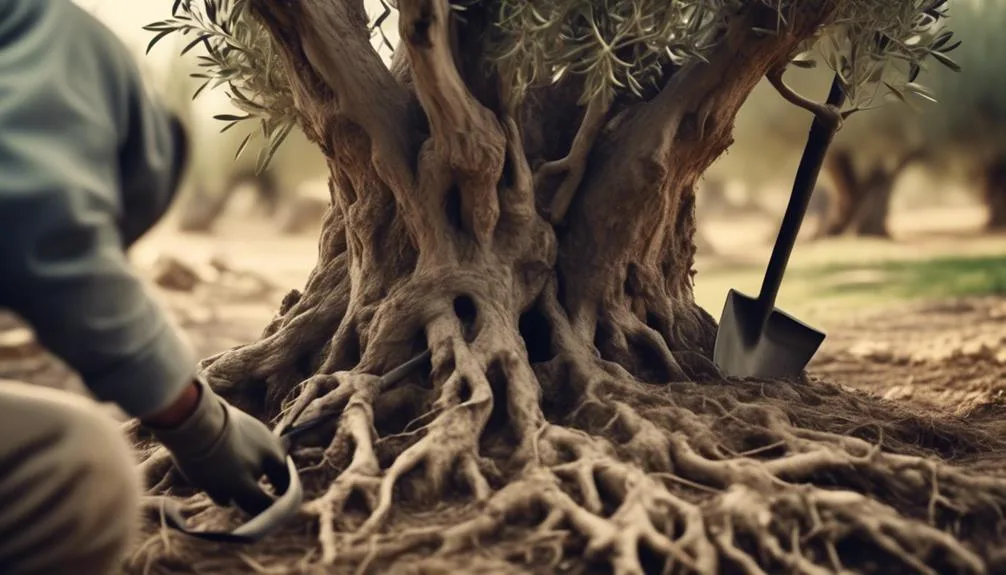Caring for your olive trees is important for their health and well-being. However, dealing with root issues can be challenging.
Identifying problems, preventing diseases, and managing root rot are all crucial for keeping your olive trees in good shape.
If you start seeing signs of root distress, there are solutions to help you tackle these issues and protect the vitality of your olive trees.
Key Takeaways
- Wilting leaves or stunted growth may indicate root issues in olive trees.
- Proper drainage and avoiding overwatering are crucial to prevent root damage.
- Regularly inspect roots for signs of disease, such as discoloration or rot.
- Implement mulching techniques to protect olive tree roots and promote overall root system health.
Identifying Olive Tree Root Issues
If you notice wilting leaves or stunted growth in your olive tree, it may indicate underlying root issues that require prompt attention. Identifying root diseases early is crucial for maintaining the health of your olive tree.
Look for signs of root rot, such as brown and mushy roots, or fungal growth around the base of the tree. Prevention is key to avoiding root damage. Ensure proper drainage around the tree to prevent waterlogging, which can lead to root rot. Use well-draining soil and avoid overwatering.
Regularly inspect the roots for any signs of damage or disease. By catching issues early, you can take steps to address them before they jeopardize the health of your olive tree. Preventative measures and early detection are essential for maintaining strong, healthy roots.
Preventing Olive Tree Root Problems
To prevent olive tree root problems, it's crucial to ensure proper drainage and avoid overwatering, as these are key factors leading to root damage. Implementing preventive measures is essential for maintaining the health of your olive tree roots.
When planting new trees, choose a well-draining location and avoid areas prone to waterlogging. Prioritize root maintenance by regularly inspecting the soil for excess moisture and adjusting watering schedules accordingly. Mulching around the base of the tree can help regulate soil moisture and prevent water accumulation.
Additionally, consider the size of the planting hole to ensure adequate space for root expansion. By taking these preventive measures, you can safeguard your olive tree roots from potential issues and promote their long-term health and vitality.
Treating Olive Tree Root Diseases
When it comes to maintaining the health of your olive tree roots, addressing any potential diseases or issues promptly is crucial for ensuring the long-term vitality of your tree.
To treat root diseases, it's important to focus on promoting overall root system health. If you suspect root fungus, apply a fungicide specifically formulated for olive trees, following the manufacturer's instructions. Adequate watering and proper soil drainage can help prevent and treat root fungus.
Additionally, keeping the area around the base of the tree clear of debris and ensuring proper air circulation can aid in preventing and managing root diseases.
Regularly inspecting the roots for any signs of discoloration, rot, or other abnormalities and taking swift action can greatly contribute to the overall well-being of your olive tree.
Managing Olive Tree Root Rot
Addressing olive tree root rot requires proactive measures to mitigate the spread and impact of this damaging condition. To effectively manage and control root rot, consider the following steps:
- Pruning: Regularly prune any damaged or diseased roots to prevent the spread of root rot and promote new growth.
- Aerating roots: Improve soil drainage and aeration by loosening compacted soil around the olive tree roots, creating an environment less conducive to root rot development.
- Applying fungicides: Consider using fungicides specifically formulated to target root rot pathogens, following the manufacturer's instructions carefully to effectively combat the disease.
Protecting Olive Tree Roots From Damage
If you're looking to safeguard your olive tree roots from damage, one essential aspect involves proactive measures to mitigate the spread and impact of root issues. Protecting the soil around the base of your olive tree is crucial.
Implement mulching techniques to insulate the roots, regulate soil temperature, and retain moisture. Apply a layer of organic mulch, such as wood chips or straw, around the base of the tree, ensuring it's spread evenly to a depth of 2-4 inches. This helps to prevent soil erosion, suppress weed growth, and provide a protective barrier against temperature fluctuations.
Additionally, mulch acts as a natural buffer, reducing the risk of physical damage to the roots from mowing or trimming. By incorporating these protective measures, you can promote the health and longevity of your olive tree roots.
Conclusion
In caring for your olive trees, it's essential to stay vigilant and proactive in addressing root issues.
By identifying, preventing, treating, and managing root problems, you can safeguard the health and longevity of your olive trees.
Remember to protect the roots from damage and be on the lookout for signs of root rot.
With the right care, you can ensure that your olive trees thrive and continue to yield delicious, high-quality olives for years to come, enhancing your landscape and providing a source of enjoyment and sustenance.

